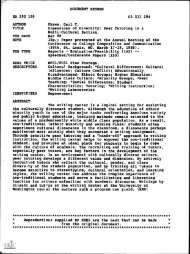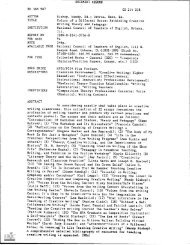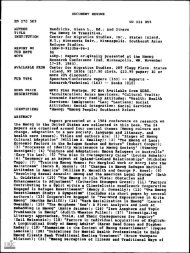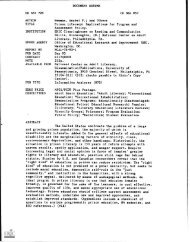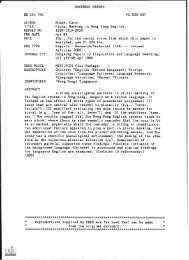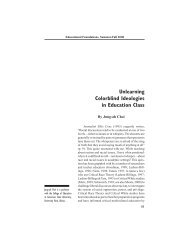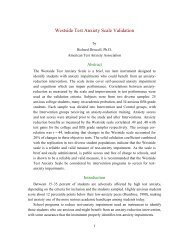Higher Education and Employment: An International Comparative ...
Higher Education and Employment: An International Comparative ...
Higher Education and Employment: An International Comparative ...
Create successful ePaper yourself
Turn your PDF publications into a flip-book with our unique Google optimized e-Paper software.
<strong>Higher</strong> <strong>Education</strong> <strong>and</strong> <strong>Employment</strong>This overall importance of career opportunities varies again accordingto the socio-economic background of the individual. In the FederalRepublic of Germany for example, the career prospects become moreimportant for students who are male, urban <strong>and</strong> have parents with high*ncome <strong>and</strong> high-level professional <strong>and</strong> educational background. Similarly,in France, the largest group of students in the faculty of medicine (42.7 percent) came from a highly placed socio-professional group, 27.4 per cent ofthe entrants to university had high-level executive parents6 <strong>and</strong> themajority of the students of psychology (67.3 per cent) <strong>and</strong> classicalliterature (86.7 per cent) were female. These figures indicate that employment<strong>and</strong> career are more important for high status students <strong>and</strong> males.In the non-market economies like the USSR <strong>and</strong> Pol<strong>and</strong>, there is somedifference in the attitude towards higher education. Wards of peasants,industrial workers <strong>and</strong> white-collar cadres attach different degrees ofimportance to the socio-professional status achieved thrc Jgh higher education.As shown in Table 2 the white-collar families in Pol<strong>and</strong> dominate thesystem of higher education whereas peasants' wards are the least numerous.Although education as a whole has the highest importance in raisingsocial status, the attractiveness of different disciplines varies for boys <strong>and</strong>g;r1s. Girls are less attracted to career-oriented courses than boys, whichindicates that the sex of the individual influences the dem<strong>and</strong> for thevarious types of higher education. This will be discussed further when wedeal with the dem<strong>and</strong> for specific disciplines.Second group of countries Those of the countries studied which enjoy asomewhat less favourable relationship between higher education <strong>and</strong>employment are Egypt, India, Indonesia, Malaysia, Pakistan, PDR Yemen,Peru, Philippines, Tanzania, <strong>and</strong> Zambia. In this group of countries career<strong>and</strong> employment opportunities come out as the most dominant factor fordetermining dem<strong>and</strong> for higher education (see Table 3). In Tanzania, 95per cent of the students surveyed indicated that good employmentopportunities <strong>and</strong> a wide choice of careers were the most important reasonsfor their pursuit of higher education.4 For the other countries this figurevaried from 57 per cent (Sri Lanka) to 86 per cent (Philippine ) (see Table3). A large majority of the individuals cite career opportunities as thedeterminant of lem<strong>and</strong> for higher education. In Democratic Yemen, whereemployment is guaranteed even for a secondary school graduate, anotherimportant factor is the contribution of higher education to social prestige,which accounts for 22 per cent of the cases. Social prestige being the resultof improved socio-professional status acquired through higher education, itbecomes related tc the career aspect of higher education. This phenomenonis ver similar to that of an industrialized socialist country such as Pol<strong>and</strong> orUSSR.One can also observe that differences in socio-economic status influencethe dem<strong>and</strong> for higher education. In the Philippines <strong>and</strong> India,3645




